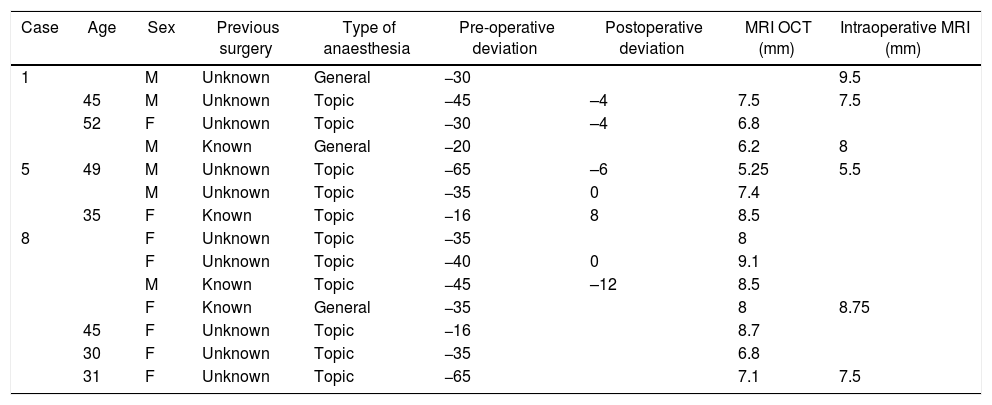To assess the agreement between the measurements of the distance from the medial rectus muscles insertion to the limbus measured by intra-operative spectral-domain optical coherence tomography (SD-OCT) in consecutive exotropia (cXT).
MethodsAn analysis was performed on total of 14 medial rectus (MR) muscles of 14 patients who underwent surgery for the treatment of cXT. The limbus-insertion distance of the MR muscles was measured using preoperative SD-OCT and intraoperatively using a calliper. The intraclass correlation coefficient (ICC) and Bland Altman plots were calculated to determine the agreement between the two methods, as well as the correlation.
ResultsMean age was 36.3 ± 16.0 years (range 13–60), with 60% being women. Mean preoperative deviation was 38.7 ± 16.9 prismatic dioptres (PD) (range 16–65), being +1.3 ± 6.3 PD (range −12 to +10 PD) after surgery. Intraoperatively the MR insertion was found at 8.7 ± 2.1 mm (range 5.5–12.0) and by OCT at 7.7 ± 1.2 mm (range 5.3–10.0). The ICC showed a moderate to good agreement (0.659; 95% confidence interval: 0.157−0.885; p < 0.001), with a correlation of R = 0.792 (p = 0.011). A better agreement was observed in those MR that were less retro-inserted.
ConclusionsSD-OCT is able to measure the insertion to the limbus distance of the medial rectus muscles that have been previously operated on, showing moderate to good agreement with intraoperative measurements. However, the agreement was poor in muscles with a large retro-insertion.
Valorar la concordancia de la medición intraoperatoria de la distancia de la inserción del recto medio (RM) al limbo corneal con la obtenida preoperatoriamente mediante tomografía de coherencia óptica de dominio espectral (SD-OCT) en pacientes con exotropia consecutiva (XTc).
MétodosSe analizaron 14 RM de 14 pacientes con XTc posquirúrgica que iban a ser reintervenidos. La distancia inserción-limbo fue medida preoperatoriamente mediante SD-OCT y de forma intraoperatoria con compás. Se calculó el coeficiente de correlación intraclase (CCI) y un análisis de Bland Altman para analizar la concordancia de las medidas, estudiándose además la correlación de las mismas.
ResultadosLa edad media fue 36,3 ± 16,0 años (rango 13–60), siendo el 57% mujeres. La desviación ocular media preoperatoria de la XT fue 38,7 ± 16,9 dioptrías prismáticas (DP) (rango 16 a 65), siendo el resultado tras la cirugía de +1,3 ± 6,3 DP (rango −12 a +10 DP). Intraoperatoriamente se halló la inserción del RM a 8,7 ± 2,1 mm (rango 5,5–12,0) y con OCT a 7,7 ± 1,2 mm (rango 5,3–10,0). El CCI mostró una concordancia moderada-buena (0,659; intervalo de confianza al 95%: 0,157–0,885; p < 0,001), hallándose una correlación de R = 0,792 (p = 0,011). Se observó una mayor concordancia en aquellos RM que se hallaban menos retroinsertados.
ConclusionesLa SD-OCT puede ser una técnica útil para valorar la distancia de la inserción al limbo corneal de los RM previamente retroinsertados, hallándose una concordancia moderada-buena con la medida intraoperatoria. Sin embargo, la concordancia fue baja en músculos muy retroinsertados.










